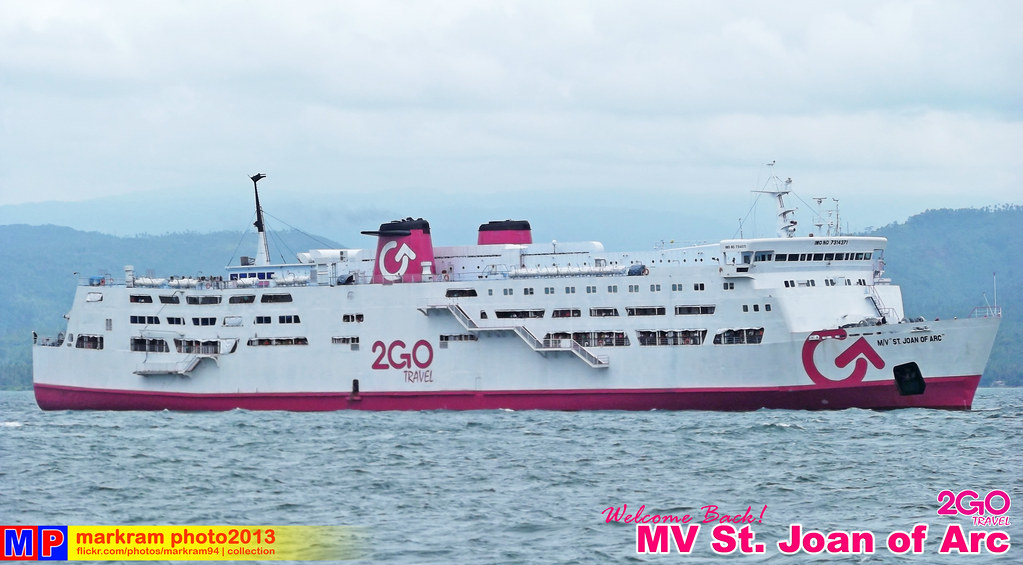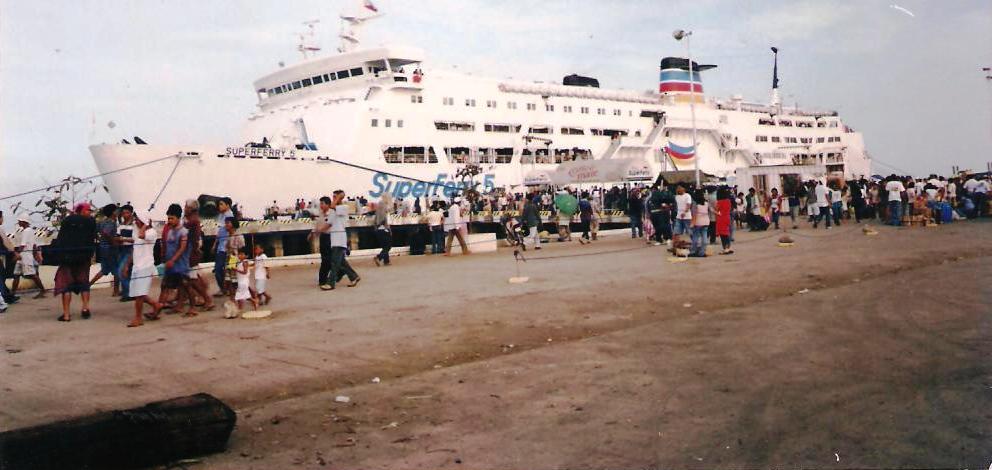
With the great decline of the liner industry in the Philippines (from about 60 in 1998 to only about eight sailing at the start of 2015) almost nobody notices that the M/V St. Joan of Arc, the former SuperFerry 5, is now the eldest liner in the Philippines both in date of construction and in the number of years in service which is now 20. Long for sale and laid up (or more precisely anchored offshore) many times, she claimed this record maybe because of good luck on her part and bad luck on the part of her fleet mates. It was obvious then that 2GO was gearing to retain her sister St. Thomas Aquinas, the former SuperFerry 2, as shown by her refurbishing and increased speed of 19 knots, which was even better that when she first came here in 1992, as compared to SuperFerry 5’s 17 knots. However, she went down after a collision with Sulpicio Express Siete in Mactan Channel in August of 2013. After that M/V St. Gregory the Great, the former SuperFerry 20, grounded in a reef near Guimaras and sustained damage that was considered beyond economic repair (BER). With no spare ships it looks like JOA, as she is known in abbreviation, might sail on for a while.
St. Joan of Arc is actually a liner (a multi-day ship) but she also belongs to that class of ship which landlubbers (including landlubber officials) call as “overaged” which at even with the most generous allowance means ferries over 40 years old. 40 years marks a special milestone in ships because in the decades past this should be the age when ships are already conking out and ready to die due to metal fatigue and unreliability. But many seriously underestimated the ships, the ability of her caretakers and the availability of surplus and CNC-milled parts. It might look funny to some but we now have a collection of about 100 ferries that are over 40 years old and that number does not include the cargo ships!
St. Joan of Arc was built by Onomishi Zosen in Onomichi, Japan for Meimon Car Ferry. She was completed in May 1973 and was christened the Ferry Hakozaki. She is one of three sister ships built in that shipyard and the other two were Ferry Sumiyoshi which became the St. Thomas Aquinas and Golden Okinawa which became the Cagayan Bay 1 of Gothong Shipping Corp. Her over-all length (LOA) was 138.6 meters and she had a breadth of 22.2 meters and a GT (Gross Tonnage) of 7,287. She was powered by two Mitsubishi-MAN diesel engines developing 15,200 horsepower that gave her an original speed of 19-19.5 knots.

She was renamed as the Ferry Cosmo in 1992 and in 1994 she came to Aboitiz Shipping Corp. to become the SuperFerry 5. In the country her GT rose to 11,638 although her superstructure did not change much. Her NT (Net Tonnage) also rose to 6,466 and her passenger capacity was bumped to 2,332. She started sailing at the start of 1995 and she was inaugurated before her fourth voyage with then Aboitiz endorser Sharon Cuneta in attendance. She then sailed the Manila-Iligan route for Aboitiz Shipping via Cebu. Her service speed then was 17.5-18 knots but it was known she can run faster than that. She can pass underneath the Mactan bridges as one of her features was a folding stern mast.
In 1996 she was overtaken by the merger of William Lines Inc., Carlos A. Gothong Lines Inc. and Aboitiz Shipping Corp. which created the William, Gothong and Aboitiz Corp. (WG&A). She retained her old name and initially even her Iligan route. One positive change, though, is the conversion from paid meals into free meals as before the merger there was no free food in Aboitiz Shipping Corp. (the operation was cafeteria-type). Initially right after the merger it was still paid meals but passenger protest was fierce and very vocal especially from William and Gothong regulars and so WG&A instituted the traditional free meal system.

Cleanliness, order and snappy service were the hallmarks of the ship from the very start. Unlike other ferries then when it was an effort to call service personnel, in SuperFerry 5 there will be always someone on duty and on call in every accommodation and cabins have their own telephones should a service crew is needed. And every so often a cleaner will appear even if the accommodations were not dirty. Right after someone used the bathroom or the toilet a utility person will appear, check it up and even wipe the mirror and basin. Cleaning and mopping of the restaurant was also a constant chore especially since it is open 18 hours and it also serves as the main lounge. Maintenance crew will also immediately retouch any surface that showed rust. Everything was spic and span then. There were even premium features like a first-class paid restaurant and the famed “Gloria Maris” chain operated it. This was also the dining room of the first class passengers. There was also a Shakey’s Pizza Parlor but unfortunately both services did not last long for lack of patronage.

Not long after, WG&A “rationalized” routes which meant culling of ships and maximizing sailing time with few in-port hours and she was paired with SuperFerry 2 and SuperFerry 9 to run routes that were not in a weekly or twice-weekly cycle. Afterwards, like in the rest of the WG&A fleet she was assigned different routes that were changing all too often for effective monitoring.
Less than a decade after the “Great Merger”, CAGLI and William Lines decided to opt out of the merger. WG&A subsequently was renamed as the Aboitiz Transport System (ATS). SuperFerry 5, however retained her name but was not treated the same. Slowly, she lost favor as ATS preferred the ferries they converted into twin cargo decks like the SuperFerry 12, SuperFerry 9, SuperFerry 2 and later the SuperFerry 20 and SuperFerry 21. ATS lacked cargo ships then and they reasoned a twin cargo deck ship will work just as fine but not really because when a ROPAX route is dropped, the cargo service also disappears.

After several years, the merger of Negros Navigation and Aboitiz Transport System finally happened after fits and starts. SuperFerry 5 was then renamed the St. Joan of Arc but again she was not in favor and was put up for sale. Especially after the grounding in Coron, Palawan she was mainly unused as the Negros Navigation ships were favored over her like the repair of the then sickly already St. Joseph the Worker and sister St. Peter the Apostle and the continued use of the slow and smoky San Paolo.
With the sale of St. Rita de Casia, the former SuperFerry 1, she is now the only ferry in 2GO that do not have twin cargo decks. So in fact, although she is the smallest now in the fleet she ironically has the biggest passenger capacity. But since liner patronage has already weakened a lot that is no longer a factor as there is no way now her full passenger capacity can be utilized.
With the mantra of “finding the right size”, a euphemism for culling of the fleet I doubt if St. Joan of Arc still has a clear future with 2GO especially with her advanced age and in the light that the long sailing hours of liners is not kind to elderly engines. She might still shoulder on but the “Grim Reaper of Ships” could just be around the corner now especially since her owner company is not exactly fond of old ships and will cull ships even without replacement. So to those who can, my advice is better sail with her now while she is still around as her time remaining might not last long.


Hope I could sail her in March. Her schedule is not fit in my schedule this time due to my classes.
LikeLike
We are currently on the ship awaiting repairs for a sailing to Zamboanga and back to Manila. After reading the story I understand how lucky that this ship became a last minute replacement for the SFX because of scheduling problems. Even better that it’s my wife’s first cruise experience!
LikeLike
wow 15years makakasakay dn aq ulit ng barko at same barko p dtng superferry 5 now st joan of arc see you st joan of arc on decmber 8 2015
LikeLike
SJOA was my very first vessel and the memories I had with her were the most memorable. Our Capt. once said, “Joan is tired. She wants to rest but she will never die.”
LikeLike